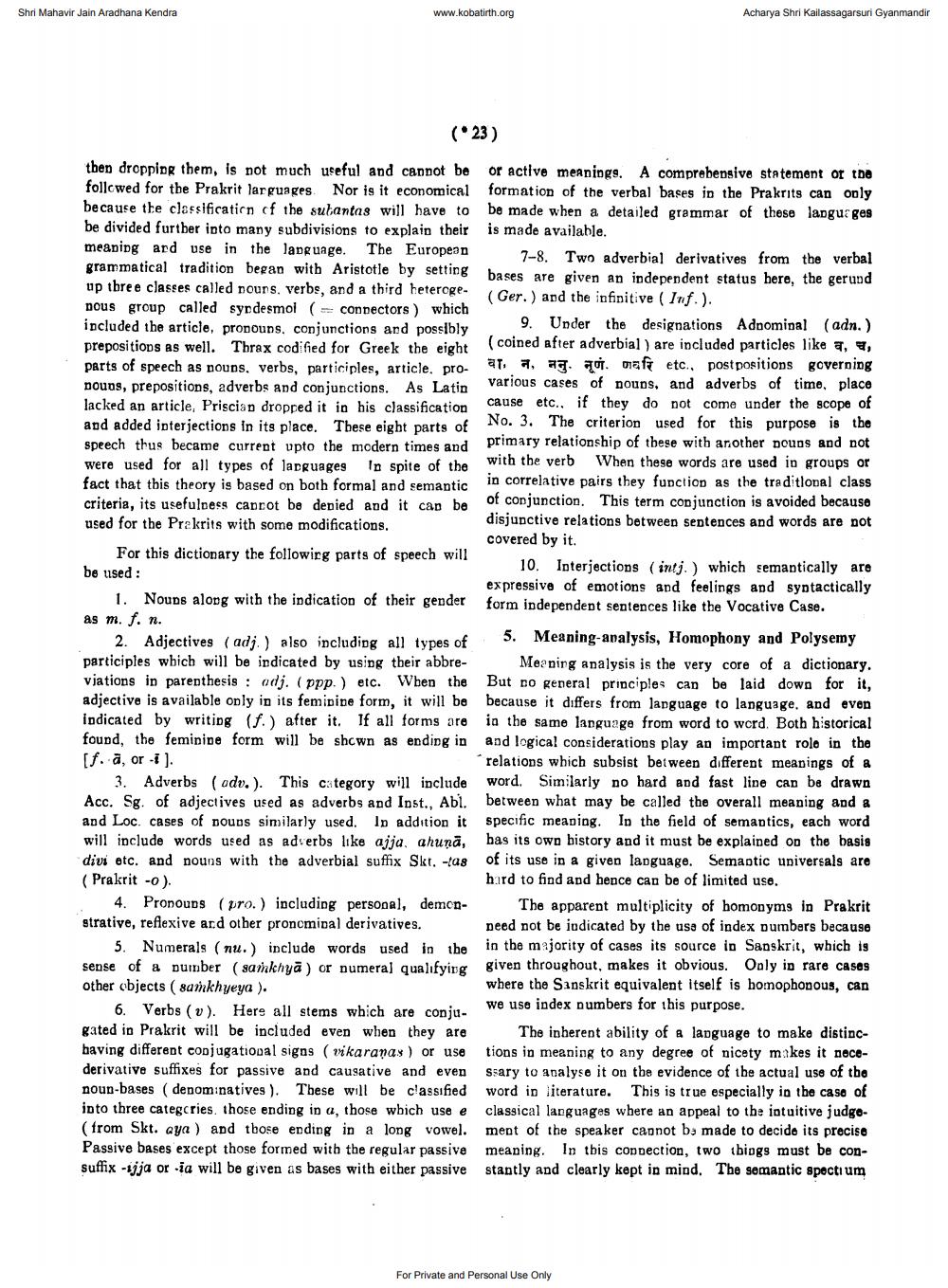________________
Shri Mahavir Jain Aradhana Kendra
www.kobatirth.org
Acharya Shri Kailassagarsuri Gyanmandir
(23)
then dropping them, is not much useful and cannot be or active meanings. A comprebensive statement of the followed for the Prakrit larguages. Nor is it economical formation of the verbal bases in the Prakrits can only because the classification of the subantas will have to be made when a detailed grammar of these languages be divided further into many subdivisions to explain their is made available, meaning and use in the language. The European 7-8. Two adverbial derivatives from the verbal grammatical tradition began with Aristotle by setting bases are given an independent status bere, the gerund up tbree classes called nouns. verbs, and a third heteroge- (Ger.) and the infinitive (Inf.). nous group called syrdesmol ( connectors) which included the article, pronoups. conjunctions and possibly
9. Under the designations Adnominal (adn.) prepositions as well. Thrax codified for Greek the eight (coined after adverbial ) are included particles like a parts of speech as noups. verbs, participles, article. pro
ples, article pro at , ag. . Daft etc.. postpositions governing nouds, prepositions, adverbs and conjunctions. As Latin
various cases of nouns, and adverbs of time, place lacked an article, Priscian dropped it in his classification
otion cause etc.. if they do not come under the scope of and added interjections in its place. These eight parts of
No. 3. The criterion used for this purpose is the speech thus became current upto the modern times and
primary relationship of these with another poups and not
Pr were used for all types of languages in spite of the
with the verb When these words are used in groups or fact that this theory is based on both formal and semantic
in correlative pairs they function as the traditlonal class criteria, its usefulness capcot be denied and it can be
of conjunction. This term conjunction is avoided because used for the Prakrits with some modifications.
disjunctive relations between sentences and words are not
covered by it. For this dictionary the followirg parts of speech will
10. Interjections (intj.) which semantically are be used :
expressive of emotions and feelings and syntactically 1. Noups along with the indication of their gender form independent sentences like the Vocative Case. as m. f. n.
2. Adjectives (adj.) also includipg all types of 5. Meaning analysis, Homophony and Polysemy participles which will be indicated by using their abbre- Meaning analysis is the very core of a dictionary. viations in parenthesis : adj. (ppp.) etc. When the But no general principles can be laid down for it, adjective is available only in its feminine form, it will be because it differs from language to language, and even indicated by writing (f.) after it. If all forms are ia the same language from word to word. Both historical found, the feminine form will be shown as ending in and logical considerations play an important role in the [f. a, ori).
relations which subsist between different meanings of a 3. Adverbs (adv.). This category will include word. Similarly no hard and fast line can be drawn Acc. Sg. of adjectives used as adverbs and Inst., Abl. between what may be called the overall meaning and a and Loc. cases of nouns similarly used. In addition it specific meaning. In the field of semantics, each word will include words used as adverbs like ajja, ahună, has its own bistory and it must be explained on the basis divi etc. and nouns with the adverbial suffix Skt. -as of its use in a given language. Semantic universals are (Prakrit -0).
hard to find and hence can be of limited uso. 4. Pronoups (pro.) including personal, demon- The apparent multiplicity of homonyms in Prakrit strative, reflexive ar.d other pronominal derivatives. need not be indicated by the use of index numbers because
5. Numerals ( nu.) include words used in the in the majority of cases its source in Sanskrit, which is sense of a number (saikhyā) or numeral qualifying given throughout, makes it obvious. Only in rare cases other objects ( samkhyeya ).
where the Sanskrit equivalent itself is homophonous, can
we use index numbers for this purpose. 6. Verbs (v). Here all stems which are conju. gated in Prakrit will be included even when they are The inherent ability of a language to make distinchaving different conjugational signs (vikaranas) or use tions in meaning to any degree of nicely makes it necederivative suffixes for passive and causative and even ssary to analyse it on the evidence of the actual use of the noun-bases (denominatives). These will be classified word in literature. This is true especially in the case of into three categcries, those ending in a, those wbich use e classical languages where an appeal to the intuitive judge(from Skt. Qya ) and those ending in a long vowel. ment of the speaker cannot bmade to decide its precise Passive bases except those formed with the regular passive meaning. In this connection, two things must be consuffix -ujja or ia will be given as bases with either passive stantly and clearly kept in mind. The semantic spectrum
For Private and Personal Use Only




